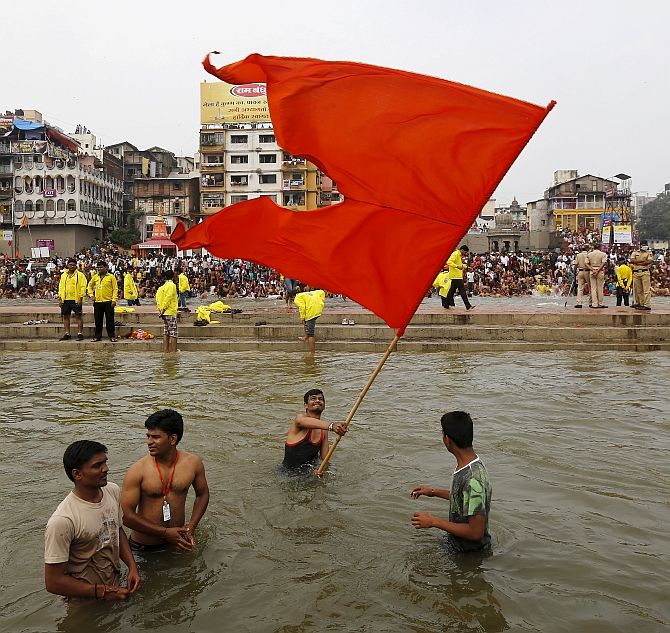
The RSS does not mind playing politics with religion-based census data despite knowing well that it is completely flawed, says Syed Firdaus Ashraf.
‘Hindus are dying,’ wrote Punjab Hindu Sabha leader U N Mukherjee in 1909.
Mukherjee’s argument was that Muslims were polygamous and hence produce more children and breed faster than the Hindu community.
Mukherjee was living in pre-Partition India where he felt Hindus would soon become a minority.
More than 100 years later, Rashtriya Swayamsevak Sangh chief Mohan Bhagwat was blowing the same trumpet when he said in Agra, “Which law says the population of Hindus should not rise? What is stopping them when the population of others is rising?”
Note: Do I need to identify the "others" he is referring to? He was harping on his pet bogey, the Muslims.
But is what he said -- that "the population of others is rising" -- a fact?
Bhagwat’s statement was based, no doubt, on the census figures. In 1951 it put the Hindus at 84.1 per cent of India's population, which dropped to 79.80 per cent in the 2011 census.
In the same period, the Muslim population rose from 9.8 per cent to 14.23 per cent.
If the two communities keep up this rate of decline/growth, then in another 345 years for Muslim population will stand at 49.23 per cent while Hindus will be 44.23 pc.
But this scenario will be achieved only if the Hindu population drops by 4.30 per cent every 60 years and the Muslim population grows by 4.43 per cent every 60 years.
However, there is a catch here which many people seem to have missed out on.
In the last decade, both Hindu and Muslim populations stopped growing as fast: while the Muslim population grew by 0.8 per cent, the Hindu population declined by 2.15 pc during 2001-11.
Now if you go by this trend, then it will take the year 2461 for Muslims to grow to 50.23 per cent of India's population, that is another 445 years.
However, you can argue that if the Hindu population decreases by 2.15 per cent every decade, then it will only take 135 years for them to fall below the 50 per cent mark. In 2151 India will have 48.25 pc of Hindus.
In this period, if the Muslim population grows by the same percentage as in the last decade, 0.8 pc, then in the year 2151 the Muslim population will only be at 25.43 per cent of India’s population. Together, the two communities will only add up to 73.68 per cent of the population.
So who will then constitute the rest of the population, amounting to 26.32 pc? After all, according to the same census figures, the population of Christian, Sikh, Buddhist, Jain and Parsi communities were all falling by some percentage points.
So what is the truth behind the population bogey?
The answer is, India has a flawed way of compiling population statistics.
The truth about Hindu and Muslim populations in the future can only be analysed by statisticians who will have to calculate various aspects like birth/death rates of Hindus vis a vis birth/death rates of Muslims and extrapolate all the available data.
But then, who is interested in finding out the truth at a time when myth is fact and fact is myth?
Nobody wants to seek out honest answers, and people only go by perceptions rather than leaving such things to the experts.
The history of census data has always created a controversy. The British knew this when they first introduced India's population census in 1871.
By providing religion-wise statistics, the British put the fear of the Hindu majority in Muslim minds and thus was sown the seeds of Partition.
In the 1871 census, the Hindu population was 73 per cent and that of Muslims was 21 per cent. More here. (external link).
Muslims were only 21 per cent of the total population in 1871 in spite of Bhagwat’s supporters believing that 800 years of Muslim saw saw mass conversions to Islam.
The British cleverly utilised the census data for their divide-and-rule policy. Not only did they put out religion-wise breakup, subsequently they started releasing the breakup of Hindus according to caste.
They knew very well that caste divided Indians more than anything else. No wonder, after the last official caste data was released by the British government in 1931, independent India has not released this data.
But the data has been available with successive governments, including the present one, all of who realise its explosive potential.
However, the RSS does not mind playing politics with religion-based census data despite knowing well that it is completely flawed.
But, then, its aim is not statistical accuracy but to spread Muslim phobia in the Hindu voter's mind.
Image: Devotees take a dip in the Godavari river during the Kumbh Mela in Nashik on September 13 last year. Photograph: Adnan Abidi/Reuters.










